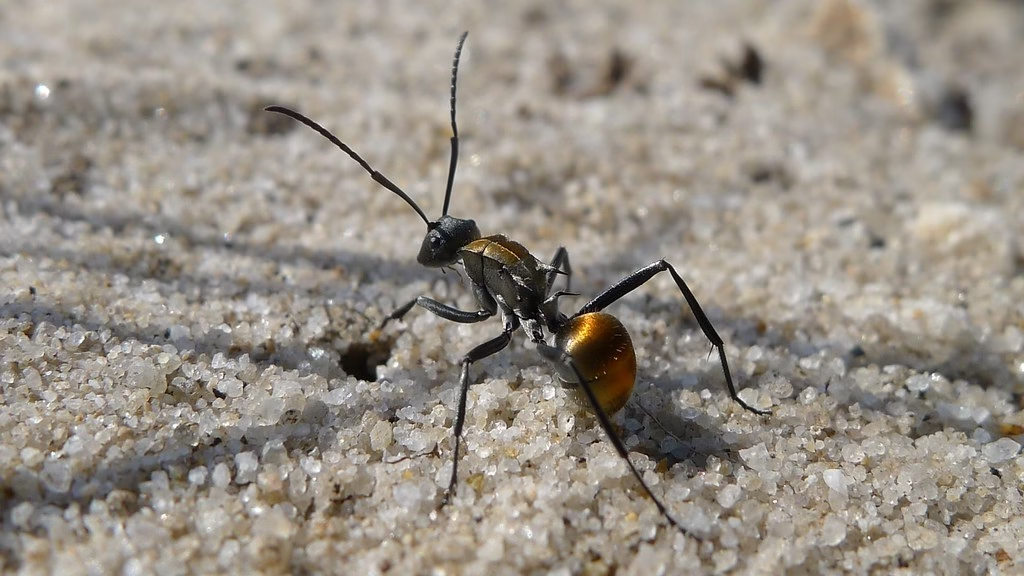| Scientific Name | Polyrhachis ammon |
| Common Name | Golden Spiny Ant |
| Size | Workers: 6–10 mm | Queens: 10–12 mm |
| Lifespan | Queens ~10+ years | Workers ~1–2 years |
| Colony Type | Monogynous (Single Queen) |
| Foraging Activity | Diurnal (active during the day) |
| Natural Habitat | Coastal and dry woodland regions across northern & eastern Australia |
| Nuptial Flights | Late spring to early summer (Oct–Dec), late afternoon–evening |
| Hibernation | No true hibernation; reduced activity in cooler months |
| Founding Style | Semi-claustral – queen requires feeding during the founding stage |

1. Introduction to Golden Spiny Ants
Golden Spiny Ant care suits keepers who love an eye-catching display species with active daytime foraging. The Golden Spiny Ant (Polyrhachis ammon) is instantly recognisable by its metallic golden abdomen and spiny, armoured thorax.
These ants are typically ground nesters in dry woodlands, bushlands and open forests. You’ll find nests in loose soil, leaf litter, or decayed wood, often at the base of trees or beneath rocks. Their striking colour and steady activity make them excellent for observation and photography.
2. Natural Habitat and Distribution
Golden Spiny Ants occur mainly in northern and eastern Australia, including parts of Queensland, New South Wales, the Northern Territory, and northern Western Australia. Typical sites include:
- Queensland: eucalyptus woodlands and dry sclerophyll forests
- New South Wales: open bushlands and semi-arid regions
- Northern Territory: dry savannahs and scrublands
- Northern Western Australia: dry woodlands and sparse vegetation zones
Nesting preferences:
- Ground nesting in loose soil, decaying logs, or leaf litter
- Dry & warm environments with good ventilation
- Often near tree bases, roots, or under stones
📖 External resource: see Polyrhachis ammon on AntWiki for scientific background.
🔗 Related Guide: How to Find Queen Ants in Australia
3. Nuptial Flights – When and Where to Catch a Queen
Golden Spiny Ant queens fly during the warmer months and typically settle in dry, sheltered areas when founding a colony.
When do they fly?
- Peak season: late spring to early summer (October–December)
- Weather: warm, humid evenings following rain
- Time of day: late afternoon to early night (5–9 pm)
How to identify a queen:
- Larger size (~10–12 mm) with a bulkier thorax
- Metallic golden sheen on the abdomen
- Often seen on low vegetation or bark near prospective nest sites
🔗 Related Guide: What to Do with a Queen Ant After Capture
4. Founding Stage – Test Tube Setup
Queens are semi-claustral and must be fed during the founding phase.
Test tube setup:
- Tube size: 16–20 mm diameter (glass or plastic)
- Water reservoir: ~1/3 full, sealed with cotton
- Cotton plug: airflow while preventing escapes
- Feeding: small insects or honey water every few days
- Storage: dark, undisturbed, 24–28 °C
When to move: wait until there are 15–20 workers before transferring to a small formicarium.
🔗 Related Guide: The Perfect Test Tube Setup for Queen Ants
5. Golden Spiny Ant Care – Housing & Nesting Requirements
Golden Spiny Ants thrive in well-ventilated formicaria with steady humidity control. For long-term Golden Spiny Ant care, use secure lids and PTFE barriers—these are skilled climbers.
Best nest types:
- Acrylic nests – well ventilated and easy to monitor
- 3D-printed nests – customisable and expandable modules
- Naturalistic setups – leaf litter, soil and rock features to mimic the wild
🚨 Warning: They climb extremely well. Ensure tight-fitting lids and fresh PTFE barriers to prevent escapes.
🔗 Related Guide: Moving Your Queen Ant to a Formicarium
6. Golden Spiny Ant Care – Feeding & Diet
Polyrhachis species are sugar-loving foragers that still require protein for brood development.
Best foods:
- Sugars (primary energy): honey water, sugar water, soft fruits
- Protein (larvae & queen): small insects such as fruit flies, crickets, mealworms
- Occasional treats: coconut nectar, diluted flower sap
Feeding frequency: offer sugars daily and protein 2–3 times per week; remove leftovers to prevent mould.
For more detail on their diet and biology, see AntWiki.
🔗 Related Guide: The Ultimate Ant Feeding Guide
7. Seasonal Dormancy & Hibernation
No true hibernation, but activity may slow in winter:
- Dormancy window: May–August
- Temperature: maintain ~18–22 °C
- Feeding: reduce frequency; always provide fresh water
8. Common Problems & Troubleshooting
Problem: Queen isn’t laying eggs
- Too much disturbance – check only every 1–2 weeks
- Temperature too low – keep 24–28 °C
- Infertile queen – if only male eggs appear, mating was unsuccessful
🔗 Related Guide: How to Keep Your Ants Safe from Mites and Pests
Final Thoughts
Golden Spiny Ants (Polyrhachis ammon) are a striking display species with steady daytime activity. With secure housing, careful moisture control, and a reliable sugar-first feeding routine, Golden Spiny Ant care is both fascinating and rewarding for intermediate to advanced keepers.
